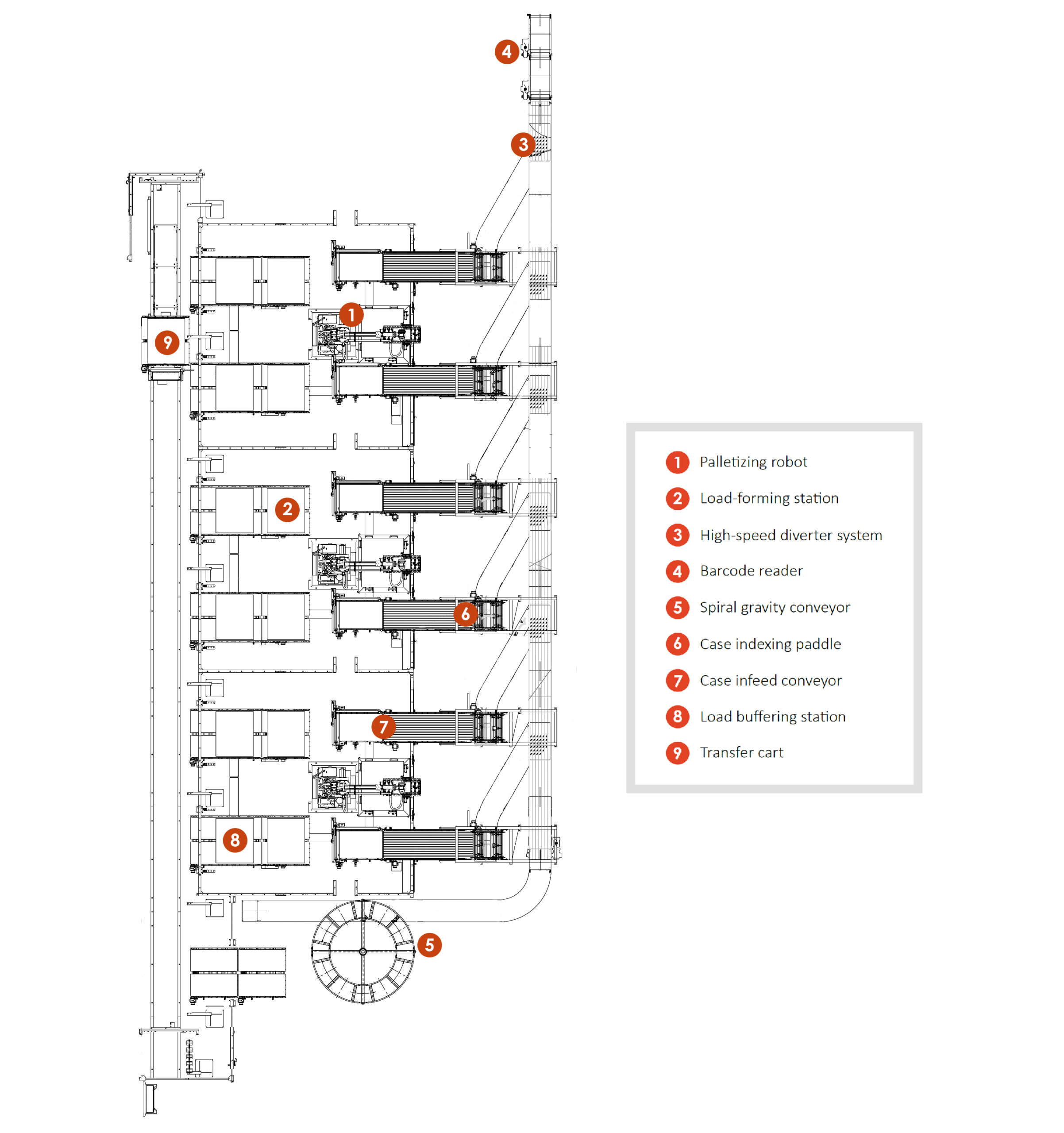A frozen seafood manufacturer needed to upgrade its legacy mechanical palletizers, which were unable to support anticipated throughput demands. This long-term customer was looking for a flexible and reliable solution that could handle multiple SKUs and varying case sizes and pallet patterns, all within the existing floorspace.
Descripción del proyecto
Objetivo 1: Production increase of 30% within limited floor space
Current production demands and anticipated rate increases required a flexible solution that could accommodate at least 60 cases per minute (cpm). Additional flexibility for further growth within the existing footprint was also highly desired.
Soluciones Pearson
Three palletizing cells with M410iB/140H robots support the necessary 30% increase to 60 cpm, with additional capacity up to 90 cpm for an overall production increase of 95%.
Full cases are palletized directly onto a slip sheet. A transfer cart replaces extensive outfeed conveying while fork trucks move the completed loads directly from the cell to the downstream operations. Load buffering stations ensure continued operations while the completed pallet awaits takeaway transport.
Objetivo 2: Handle large SKU variety with minimal downtime
The solution needed to handle up to 82 SKUs and 16 different stack patterns for high-volume and small-batch runs. Downtime from complicated, time-consuming changeovers needed to be minimized.
Soluciones Pearson
Each robot is equipped with a multi-function end-of-arm tool (EOAT) to pick both, slip sheets and cases. Independent vacuum zones regulate suction to accommodate different case sizes, weights and quantities without changeovers.
A high-speed sortation system with barcode scanner identifies and directs cases to the appropriate palletizing cell, while a spiral gravity conveyor transports rejected cases or small-batch runs to ground level for manual handling.
The HMI’s Pallet Configuration Tool enables easy recipe selection and pallet modifications to transition quickly to new product runs.
Objetivo 3: Quick turnaround with assurance of system viability
Delivery of the solution needed to coincide with the customer’s pre-scheduled facility renovations to keep the production schedule on time. To reduce the risk of potential obstacles, the customer desired validation of the proposed solution’s viability, as well as guaranteed support post-installation.
Soluciones Pearson
Successful installation was achieved within 24 weeks, meeting the customer’s renovation timeline and minimizing impact to the production schedule.
A 3D simulation of the application in real time under varied operating conditions built the customer’s confidence in the viability of the proposed solution, while a long-term history of successful projects with Pearson reassured them of the reliability and availability of ongoing service support.
Secuencia de operaciones
This system consists of three connected palletizing cells, each with one M410iB/140H palletizing robot, two load-forming stations and a slip sheet magazine.
Once a recipe is selected for each individual palletizer, the operation starts when the palletizing robot (1) picks a slip sheet and places it on the load-forming station (2).
As cases enter the high-speed diverter system (3) from the second floor, a barcode reader (4) scans each case and determines which cell each case is conveyed to. Cases with unreadable or incorrect barcodes are rejected via a spiral gravity conveyor (5).
Scanned cases are sorted into the appropriate lane, then transferred 90° by an indexing paddle (6) onto the case infeed conveyor (7). A metering stop engages when the required number of cases have accumulated, while a reference bar aids in accurately positioning them. A photoeye sensor then signals the robot for picking.
Each robot employs a custom EOAT with independent vacuum zones that pick two to four cases at a time, depending on the selected recipe. Cases are stacked onto the load-forming station in the proper orientation, and tier sheets are added if specified by the recipe.
Complete loads convey to the buffering station (8), freeing up the forming station for continued palletizing. A sensor signals the transfer cart (9) to accept the completed load and transport it to the stretch wrapper. Once the load-forming station is clear, the robot picks and places another slip sheet and the operation repeats.



